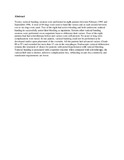| dc.contributor.author | Jani, PG | |
| dc.date.accessioned | 2013-10-23T06:55:04Z | |
| dc.date.available | 2013-10-23T06:55:04Z | |
| dc.date.issued | 199 | |
| dc.identifier.uri | http://erepository.uonbi.ac.ke:8080/xmlui/handle/123456789/57838 | |
| dc.identifier.uri | http://www.ncbi.nlm.nih.gov/pubmed/9487405 | |
| dc.description.abstract | Twenty variceal banding sessions were performed in eight patients between February 1995 and September 1996. A total of 69 rings were used to band the varices and at each session between two to six rings were used. Two of the eight had active bleeding and both underwent variceal banding to successfully arrest their bleeding as inpatients. Sixteen other variceal banding sessions were performed on an outpatient basis to obliterate their varices. Four of the eight patients had had sclerotherapy before and varices were still present. No acute or long term complications were noted. In one patient, variceal banding could not be performed as he developed stridor upon placement of the overtube. All the patients had advanced varices (Grade III or IV) and extended for more than 15 cms in the oesophagus. Endoscopic variceal obliteration remains the treatment of choice for patients with portal hypertension with variceal bleeding. Variceal banding is associated with a superior outcome when compared with sclerotherapy; the variceal kill time is shorter, infective complications less, rebleeding occurs less commonly and transfusion requirements are lower. | en |
| dc.publisher | University of Nairobi | en |
| dc.title | Oesophageal variceal banding: report of the first eight cases in Kenya. | en |
| dc.type | Article | en |
| local.publisher | College of Health Science | en |

